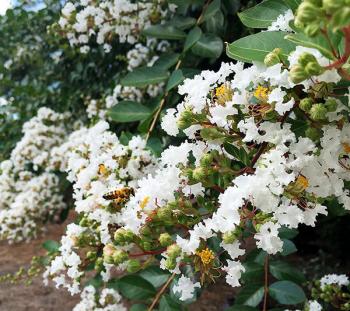
A bee works the flowers of an Acoma crape myrtle.
--LSU AgCenter Photo/Yan Chen.
Summer brings crape myrtle blossoms
HAMMOND — March and April were not kind to spring growth on crape myrtles this year, with rain and clouds hampering growth. “But we are seeing nice blooms on these great summer-flowering landscape trees as we reach their peak performance time of late June through July,” said LSU AgCenter horticulturist Allen Owings.
Keys to success with crape myrtles include correct sunlight, ideal soil pH and drainage, proper pruning, regular fertilization, proper mulching and insect control, Owings said.
Crape myrtles need full sun in order to perform, grow and bloom their best. This means eight hours or more of direct sun daily. Less than eight hours of sunlight daily is not sufficient for ideal performance.
“Many of us underestimate the amount of sun our landscape receives,” Owings said. “To get a better handle on this, check your sun patterns in the morning, during the middle of the day and again in late afternoon.”
Crape myrtles do best in a soil with a pH of 6.0-6.5, which is considered slightly acid.
“You can lower the pH level with sulfur products and raise it with lime products. But always do this based on the results of a soil test,” he said.
February is the best time to prune crape myrtles, but when it is needed, prune them to maintain a natural shape or to thin out branches.
Fertilization is important for crape myrtles. “A fertilizer like 8-8-8 or 13-13-13 will work fine,” Owings said.
It is best to place fertilizer in holes drilled in the ground about 8 inches deep.
“You can fertilize later in the spring and in the summer, but it’s not as effective as when fertilizer is applied earlier in the year,” he said.
Mulching is done to manage weeds and conserve soil moisture. “Unfortunately, it’s done incorrectly in many residential and commercial landscapes these days,” Owings said. “You may see mulch piled around the base of a tree. Do not do this.”
Spread mulch outward toward the ends of the branches, and use pine straw, pine bark or wood chips to a depth of 2 inches to 3 inches, he said. Refresh the layer of mulch as needed, keeping mulch off the stems and lower trunk.
Insects generally don’t do much damage to crape myrtles, but aphids feeding on new shoots in spring can be a problem. These insects will release their bodily fluids onto the foliage, and the resultant honeydew leads to sooty mold on the leaves.
This is the black discoloration that occurs in early summer through fall. Control the insects and no sooty mold will develop, Owings said.
“Crape myrtles provide pollen but not nectar to pollinators,” said AgCenter horticulture researcher Yan Chen. These trees are frequently visited by many pollen-collecting pollinators, including bees, carpenter bees, certain bumblebees and flies.
“Be sure not to spray insecticides directly onto your plant for aphids or the newly spreading bark scale during the peak blooming period,” Chen said. “And check the label on your insecticides for the new bee warning information.”
Traditional crape myrtle varieties widely grown in Louisiana include Natchez, Muskogee, Tonto, Acoma and Sioux.
Newer groups and varieties of crape myrtles introduced over the past few years include the dwarf Razzle Dazzle series, the black-foliaged Black Diamond varieties, the Barnyard Collection (Purple Cow, Pink Pig and Red Rooster), the Enduring Summer series, the burgundy-foliaged Delta Jazz, the Magic series (with burgundy and black foliage) and more.
The LSU AgCenter is conducting adaptability studies for south Louisiana on these new crape myrtles at the Hammond Research Station, Owings said.
- Log in to post comments
